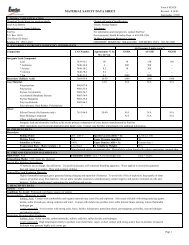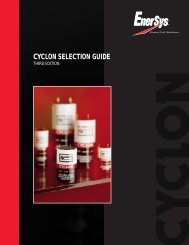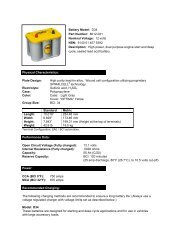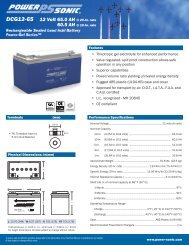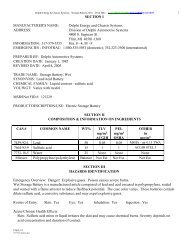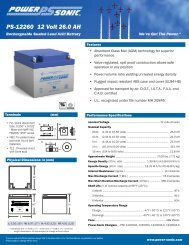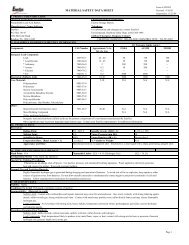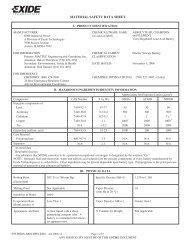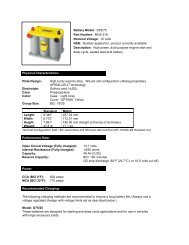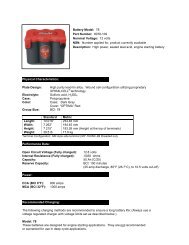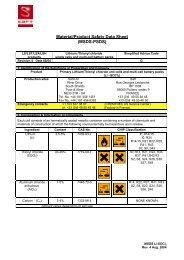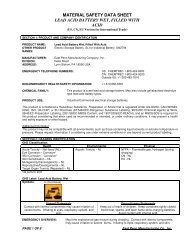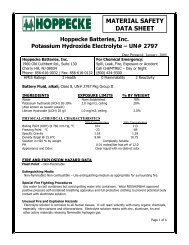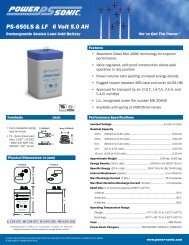SAFT-LS - Battery Web
SAFT-LS - Battery Web
SAFT-LS - Battery Web
You also want an ePaper? Increase the reach of your titles
YUMPU automatically turns print PDFs into web optimized ePapers that Google loves.
Material/Product Safety Data Sheet<br />
(MSDS-PSDS)<br />
<strong>LS</strong>/<strong>LS</strong>G/<strong>LS</strong>H/<strong>LS</strong>T<br />
Products<br />
Revision 9 Date 02/2009<br />
Lithium/Thionyl chloride<br />
single cells and multi-cell battery packs<br />
1. Identification of the Substance or Preparation and Company<br />
Product<br />
Production<br />
sites<br />
Primary Lithium/Thionyl chloride unit cells and multi-cell battery packs<br />
(Li-SOCl 2 )<br />
Saft Ltd.<br />
River Drive<br />
Tyne & Wear<br />
South Shields<br />
NE33 2TR – UK<br />
Ph. :+44 191 456 1451<br />
Fax :+44 191 456 6383<br />
Saft<br />
Rue Georges Leclanché<br />
BP 1039<br />
86060 Poitiers cedex 9<br />
France<br />
Ph. :+33 (0)5 49 55 48 48<br />
Fax :+33 (0)5 49 55 48 50<br />
www.saftbatteries.com (section “Contact”)<br />
Saft America Inc<br />
313 Crescent Street<br />
Valdese<br />
NC 28690 – USA<br />
Ph. :+1 828 874 4111<br />
Fax :+1 828 874 2431<br />
Saft Batteries Co., Ltd<br />
Zhuhai Free Trade Zone<br />
Lianfeng Road<br />
Zhuhai 519030<br />
Guangdong Province<br />
China<br />
Ph. : +86 756 881 9318<br />
Fax : +86 756 881 9328<br />
Emergency contact<br />
+1 (703) 527 3887 (CHEMTREC US Service Center)<br />
within the USA : 800 424 9300<br />
2. Hazards Identification<br />
Do not short circuit, recharge, puncture, incinerate, crush, immerse, force discharge or expose to<br />
temperatures above the declared operating temperature range of the product. Risk of fire or explosion. The<br />
Lithium-Thionyl chloride batteries described in this Safety Data Sheet are sealed units which are not<br />
hazardous when used according to the recommendations of the manufacturer.<br />
Under normal conditions of use, the electrode materials and liquid electrolyte they contain are not exposed to<br />
the outside, provided the battery integrity is maintained and seals remain intact. Risk of exposure only in case<br />
of abuse (mechanical, thermal, electrical) which leads to the activation of safety valves and/or the rupture of<br />
the battery container. Electrolyte leakage, electrode materials reaction with moisture/water or battery<br />
vent/explosion/fire may follow, depending upon the circumstances.<br />
3. Composition & Information on Ingredients<br />
Each cell consists of a hermetically sealed metallic container containing a number of chemicals and materials<br />
of construction of which the following could potentially be hazardous upon release.<br />
Ingredient Content CAS No. CHIP Classification<br />
Lithium<br />
(Li)<br />
3.5-5% 7439-93-2<br />
F; R14/15<br />
C; R34<br />
R14/15, R21,R22, R35,<br />
R41, R43<br />
S2, S8, S45<br />
MSDS Li-SOCl 2<br />
Rev. 9 February 2009
Thionyl chloride<br />
(SOCl 2 )<br />
40-46% 7719-09-7<br />
C; R14, R21, R22, R35,<br />
R37, R41,R42/43<br />
S2, S8, S24, S26, S36,<br />
S37, S45<br />
Aluminum chloride<br />
anhydrous<br />
(AlCl 3 )<br />
Carbon<br />
(C n )<br />
1-5% 7446-70-0 R14, R22, R37, R41, R43.<br />
S2, S8, S22, S24, S26,<br />
S36, S45<br />
3-4% 1333-86-4 NONE KNOWN<br />
Amount varies depending on cell size.<br />
4. First Aid Measures<br />
Inhalation<br />
Skin contact<br />
Eye contact<br />
Ingestion<br />
Further treatment<br />
Remove from exposure, rest and keep warm.<br />
In severe cases obtain medical attention.<br />
Wash off skin thoroughly with water. Remove contaminated clothing and wash<br />
before re-use. In severe cases obtain medical attention.<br />
Irrigate thoroughly with water for at least 15 minutes.<br />
Obtain medical attention.<br />
Wash out mouth thoroughly with water and give plenty of water to drink.<br />
Obtain medical attention.<br />
All cases of eye contamination, persistent skin irritation and casualties who<br />
have swallowed this substance or been affected by breathing its vapours<br />
should be seen by a Doctor.<br />
5. Fire Fighting Measures<br />
CO 2 extinguishers or, even preferably, copious quantities of water or water-based foam, can be used to cool<br />
down burning Li- SOCl 2 cells and batteries, as long as the extent of the fire has not progressed to the point<br />
that the lithium metal they contain is exposed (marked by deep red flames).<br />
Do not use for this purpose sand, dry powder or soda ash, graphite powder or fire blankets.<br />
Use only metal (Class D) extinguishers on raw lithium.<br />
Extinguishing media<br />
Use water or CO 2 on burning Li-SOCl 2 cells or batteries<br />
and class D fire extinguishing agent only on raw lithium.<br />
6. Accidental Release Measures<br />
Remove personnel from area until fumes dissipate. Do not breathe vapours or touch liquid with bare hands.<br />
If the skin has come into contact with the electrolyte, it should be washed thoroughly with water.<br />
Sand or earth should be used to absorb any exuded material. Seal leaking battery and contaminated<br />
absorbent material in plastic bag and dispose of as Special Waste in accordance with local regulations.<br />
MSDS Li-SOCl 2<br />
Rev. 9 February 2009
7. Handling and Storage<br />
Handling<br />
Storage<br />
Other<br />
Do not crush, pierce, short (+) and (-) battery terminals with conductive<br />
(i.e. metal) goods. Do not directly heat or solder. Do not throw into fire.<br />
Do not mix batteries of different types and brands. Do not mix new and used<br />
batteries. Keep batteries in non conductive (i.e. plastic) trays.<br />
Store in a cool (preferably below 30°C) and ventilated area, away from<br />
moisture, sources of heat, open flames, food and drink.<br />
Keep adequate clearance between walls and batteries.<br />
Temperature above 100°C may result in battery leakage and rupture.<br />
Since short circuit can cause burns, leakage and rupture hazard, keep<br />
batteries in original packaging until use and do not jumble them.<br />
Lithium-Thionyl chloride batteries are not rechargeable and should not be<br />
tentatively charged.<br />
Follow Manufacturers recommendations regarding maximum recommended<br />
currents and operating temperature range.<br />
Applying pressure on deforming the battery may lead to disassembly<br />
followed by eye, skin and throat irritation.<br />
8. Exposure Controls & Personal Protection<br />
Compound<br />
Occupational<br />
Sulfur dioxide<br />
exposure standard<br />
Hydrogen chloride<br />
8hr TWA<br />
1 ppm<br />
1 ppm<br />
15min TWA<br />
1 ppm<br />
5 ppm<br />
SK<br />
-<br />
-<br />
Respiratory<br />
protection<br />
In all fire situations, use self-contained breathing apparatus.<br />
Hand<br />
protection<br />
In the event of leakage wear gloves.<br />
Eye<br />
protection<br />
Safety glasses are recommended during handling.<br />
Other<br />
In the event of leakage, wear chemical apron.<br />
9. Physical and Chemical Properties<br />
Appearance<br />
Cylindrical or prismatic shape<br />
Odour<br />
If leaking, gives off a pungent corrosive odour.<br />
pH<br />
Not applicable<br />
Flash point<br />
Not applicable unless individual components exposed<br />
Flammability Not applicable unless individual components exposed<br />
Relative density Not applicable unless individual components exposed<br />
Solubility (water) Not applicable unless individual components exposed<br />
Solubility (other) Not applicable unless individual components exposed<br />
MSDS Li-SOCl 2<br />
Rev. 9 February 2009
10. Stability and Reactivity<br />
Product is stable under conditions described in Section 7.<br />
Conditions to avoid.<br />
Heat above 100 (150°C for the <strong>LS</strong>H 20-150 cells and the battery packs<br />
assembled from them) or incinerate. Deform. Mutilate. Crush. Pierce.<br />
Disassemble<br />
Recharge. Short circuit. Expose over a long period to humid conditions.<br />
Materials to avoid<br />
Oxidising agents, alkalis, water. Avoid electrolyte contact with aluminum or zinc.<br />
Hazardous<br />
decomposition<br />
Products<br />
Hydrogen (H 2 ) as well as Lithium oxide (Li 2 O) and Lithium hydroxide (LiOH) dust<br />
is produced in case of reaction of lithium metal with water.<br />
Chlorine (Cl 2 ), Sulfur dioxide (SO 2 ) and Disulfur dichloride (S 2 Cl 2 ) are produced<br />
in case of thermal decomposition of Thionyl chloride above 140°C.<br />
Hydrochloric acid (HCl) and Sulfur dioxide (SO 2 ) are produced in case of<br />
reaction of Thionyl chloride with water at room temperature.<br />
Hydrochloric acid (HCl) fumes, Lithium oxide, (Li 2 O), Lithium hydroxide (LiOH)<br />
and Aluminum hydroxide (Al(OH) 3 ) dust are produced in case of reaction of<br />
Lithium tetrachloroaluminate (LiAlCl 4 ) with water.<br />
11. Toxicological Information<br />
None, unless battery ruptures. In the event of exposure to internal contents,<br />
corrosive fumes will be very irritating to skin, eyes and mucous membranes.<br />
Signs & symptoms<br />
Overexposure can cause symptoms of non-fibrotic lung injury and membrane<br />
irritation.<br />
Inhalation Lung irritant.<br />
Skin contact Skin irritant<br />
Eye contact Eye irritant.<br />
Ingestion Tissue damage to throat and gastro-respiratory tract if swallowed.<br />
Medical conditions<br />
In the event of exposure to internal contents, eczema, skin allergies, lung<br />
generally aggravated<br />
injuries, asthma and other respiratory disorders may occur.<br />
by exposure<br />
12. Ecological Information<br />
Mammalian effects<br />
Eco-toxicity<br />
Bioaccumulation<br />
potential<br />
Environmental fate<br />
None known if used/disposed of correctly.<br />
None known if used/disposed of correctly.<br />
None known if used/disposed of correctly.<br />
None known if used/disposed of correctly.<br />
13. Disposal Considerations<br />
Do not incinerate, or subject cells to temperatures in excess of 100 o C. Such abuse can result in loss<br />
of seal, leakage, and/or cell explosion. Dispose of in accordance with appropriate local regulations.<br />
MSDS Li-SOCl 2<br />
Rev. 9 February 2009
14. Transport Information<br />
Note : when manufacturing a new battery pack, one must assure that it is tested in accordance with the UN<br />
Model Regulations, Manual of Tests and Criteria, Part III, subsection 38.3<br />
Label for conveyance<br />
UN numbers<br />
Shipping names<br />
Hazard classification<br />
Packing Group<br />
IMDG Code<br />
CAS<br />
EmS No.<br />
F-A , S-I<br />
Marine pollutant No<br />
ADR Class Class 9<br />
For the single cell batteries and multicell battery packs that are non-restricted<br />
to transport (non-assigned to the Miscellaneous Class 9), use lithium batteries<br />
inside label.<br />
For the single cell batteries and multicell battery packs which are restricted to<br />
transport (assigned to Class 9), use Class 9 Miscellaneous Dangerous Goods<br />
and UN Identification Number labels.<br />
In all cases, refer to the product transport certificate issued by the<br />
Manufacturer.<br />
UN 3090 (shipment of cells and batteries in bulk)<br />
UN 3091 (cells and batteries contained in equipment or packed with it)<br />
Lithium Metal Batteries<br />
Depending on their lithium metal content, some single cells and small multicell<br />
battery packs may be non-assigned to Class 9 (Refer to Transport Certificate)<br />
II<br />
3090 (Li batteries)<br />
3091 (Li batteries contained in equipment or packed with it)<br />
15. Regulatory Information<br />
Regulations specifically applicable to the product:<br />
- ACGIH and OSHA: see exposure limits of the internal ingredients of the battery in section 8.<br />
- IATA/ICAO (air transportation): UN 3090 or UN 3091<br />
- IMDG (sea transportation) : UN 3090 or UN 3091<br />
- Transportation within the US-DOT, 49 Code of Federal Regulations<br />
Risk phrases<br />
Lithium<br />
(Li)<br />
Thionyl<br />
chloride<br />
(SOCl 2 )<br />
Aluminum<br />
chloride<br />
anhydrous<br />
(AlCl 3 )<br />
R14/15<br />
R21<br />
R22<br />
R35<br />
R41<br />
R42/43<br />
R14<br />
R22<br />
R35<br />
R37<br />
R41<br />
R42/43<br />
R14<br />
R22<br />
R37<br />
R41<br />
R43<br />
Reacts violently with water, liberating extremely<br />
flammable gases.<br />
Harmful in contact with skin.<br />
Harmful if swallowed.<br />
Causes burns.<br />
Risk of serious damage to eye.<br />
May cause sensitization by inhalation and skin<br />
contact.<br />
Reacts with water.<br />
Harmful if swallowed.<br />
Causes burns.<br />
Irritating to respiratory system.<br />
Risk of serious damage to eye.<br />
May cause sensitization by inhalation and skin<br />
contact.<br />
Reacts with water.<br />
Harmful if swallowed.<br />
Irritating to respiratory system.<br />
Risk of serious damage to eye.<br />
May cause sensitization by skin contact.<br />
MSDS Li-SOCl 2<br />
Rev. 9 February 2009
Safety phrases<br />
UK<br />
regulatory references<br />
Lithium<br />
(Li)<br />
Thionyl<br />
chloride<br />
(SOCl 2 )<br />
Aluminum<br />
chloride<br />
anhydrous<br />
(AlCl 3 )<br />
S2<br />
S8<br />
S45<br />
S2<br />
S8<br />
S24<br />
S26<br />
S36<br />
S37<br />
S45<br />
S2<br />
S8 S22<br />
S24 S26<br />
S36<br />
Keep out of reach of children<br />
Keep away from moisture<br />
In case of incident, seek medical attention.<br />
Keep out of reach of children.<br />
Keep away from moisture.<br />
Avoid contact with skin.<br />
In case of contact with eyes, rinse immediately<br />
with plenty of water.<br />
Wear suitable protective clothing.<br />
Wear suitable gloves.<br />
In case of incident, seek medical attention.<br />
Keep out of reach of children.<br />
Keep away from moisture.<br />
Do not breathe dust.<br />
Avoid contact with skin.<br />
In case of contact with eyes, rinse immediately<br />
with plenty of water.<br />
Wear suitable protective clothing.<br />
Classified under CHIP<br />
16. Other Information<br />
This information has been compiled from sources considered to be dependable and is, to the best of our<br />
knowledge and belief, accurate and reliable as of the date compiled. However, no representation, warranty<br />
(either expressed or implied ) or guarantee is made to the accuracy, reliability or completeness of the<br />
information contained herein.<br />
This information relates to the specific materials designated and may not be valid for such material used in<br />
combination with any other materials or in any process. It is the user’s responsibility to satisfy himself as to<br />
the suitability and completeness of this information for his particular use.<br />
Saft does not accept liability for any loss or damage that may occur, whether direct, indirect, incidental or<br />
consequential, from the use of this information. Saft does not offer warranty against patent infringement.<br />
Edition 9 – February 2009<br />
Signature _____________________<br />
Nicolas Paquin<br />
Lithium Product Manager<br />
MSDS Li-SOCl 2<br />
Rev. 9 February 2009



